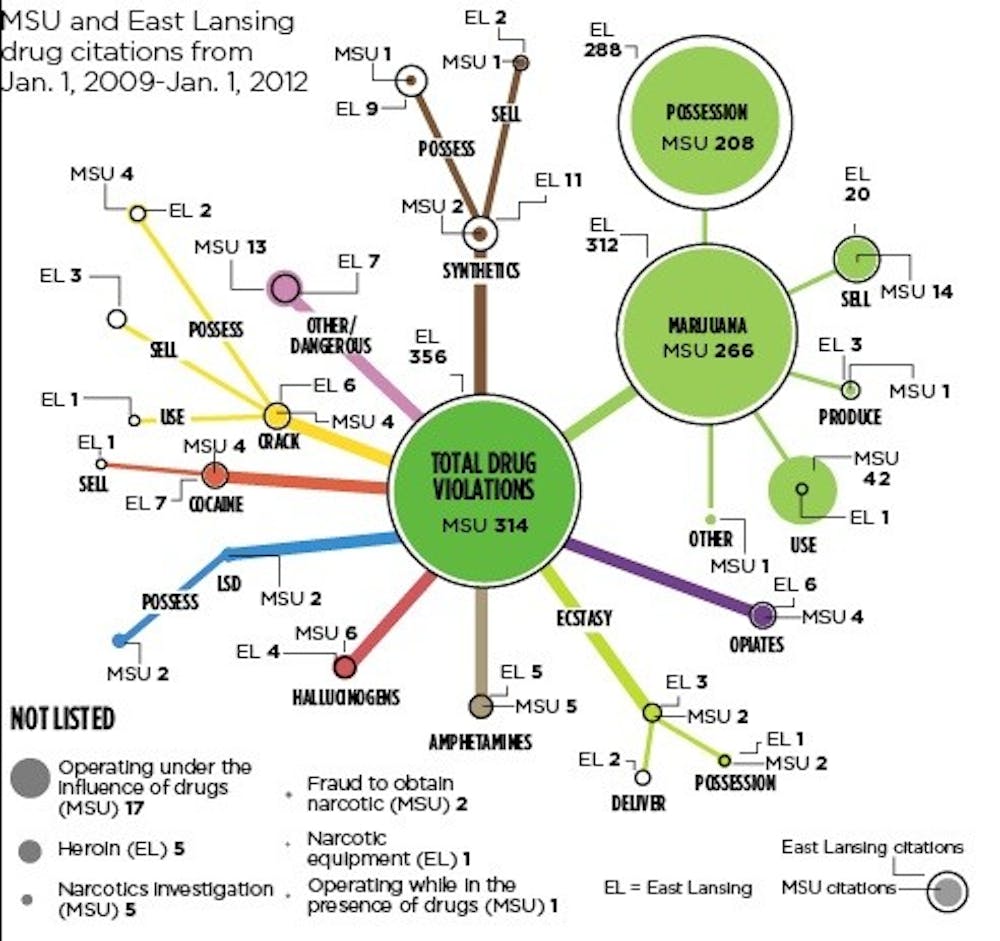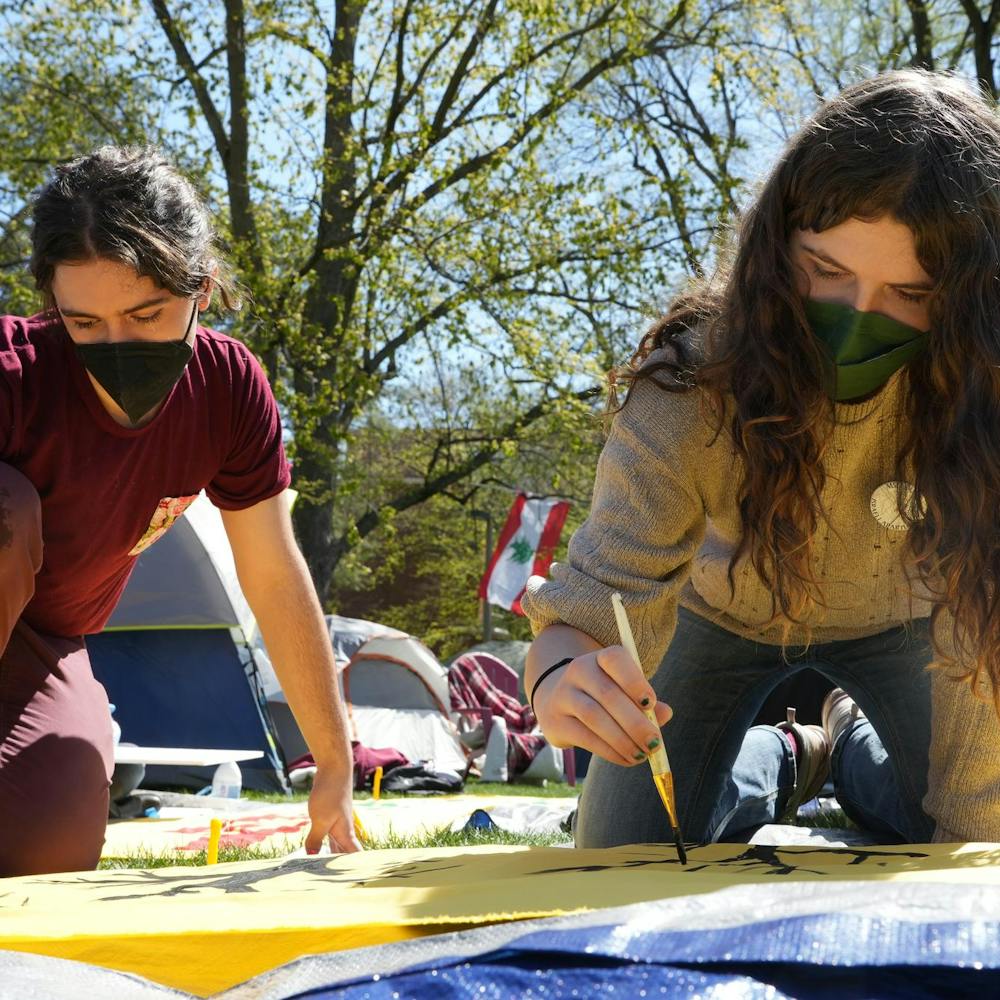Kevin Rourke was found dead on Dec. 2, 2011 in his Cedar Village apartment by East Lansing police officers. The advertising senior was 22 years old.
According to autopsy and toxicology reports from Sparrow Forensic Pathology Services obtained by The State News through Michigan’s Freedom of Information Act, Kevin Rourke died of a drug overdose. Just a few days before, 21-year-old psychology senior Nick Charboneau was found dead by roommate Sara Wennersten on Nov. 28, 2011 of a drug overdose. The cases are not connected.
Rourke died of a mixture of prescription drugs — Xanax and OxyContin — and alcohol. Charboneau died of a mixture of illicit and prescription drugs. Traces of anxiety-relieving drugs, pain-relieving drugs, morphine, a psychedelic drug and evidence of cocaine, heroin and marijuana use were found in his system.
In the wake of these two drug-related overdose deaths on campus, family, friends, officials and student drug users reflect on drug culture at the MSU and the sometimes positive, sometimes devastating consequences they can have.
A deadly addiction
Charboneau could never bring himself to tell her, but Lena Sanfilippo knew.
It was something in the way he edged around certain topics and how he acted when she found a syringe in the couch and Sanfilippo, a zoology sophomore and Charboneau’s girlfriend, asked him what it was. There was a time on Halloween weekend 2011 when he fell asleep and wouldn’t get up even when Sanfilippo’s cat sat atop him and meowed.
She knew something big was on Charboneau’s mind, but she didn’t want to push him away — so she let the topic lie.
“Sometimes I could tell, he’d be really upset, and I knew something was bothering him,” Sanfilippo said. “I knew he wasn’t sober.”
Family and friends later told Sanfilippo that Charboneau suffered from drug problems in high school, but had come to college for a fresh start and had been doing incredibly well since then. Sanfilippo said she isn’t sure when or why he started doing drugs again, but one thing was clear: He wanted to hide that part of himself from her to protect her and keep her in his life.
Recreational drug use could easily become an addiction if the user suffers physical or mental consequences but continues to use drugs anyway, said Sean McCabe, a research associate professor at the University of Michigan Substance Abuse Research Center.
McCabe, who has conducted several national studies of substance and prescription drug misuse among young people throughout the country, said addictions to illicit drugs could stem from a host of factors, including untreated mental health issues, a family history of drug problems, availability of drugs and the environment the user is in.
Depending on the drug being used, the average starting age of use varies, but McCabe said it’s most common for illicit and potentially addicting drug use to begin as early as high school.
“For example, most marijuana use begins in high school among college students, whereas most nonmedical use of prescription stimulant begins in college,” McCabe said.
Use versus abuse
If there’s a time to experiment with drugs, college is the time to do so, MSU student Bryan Wayne said.
Wayne, whose name has been changed to protect his identity, started smoking marijuana in his junior year of high school and since has experimented with molly, a powdered form of ecstasy, and mushrooms and other hallucinogens.
Because he doesn’t anticipate using drugs postcollege, Wayne said he doesn’t feel bad taking a few risks and enjoying the fun side of taking drugs here and there.
“I’m not going to be able to do this when I’m 40, or when I have kids and a job,” Wayne said. “I might as well have fun and relax now.”
Wayne does have limits. He said he would refuse to do harder drugs such as cocaine or heroin, would not do more drugs than he felt comfortable with and would interject if one of his friends appeared to be addicted to any particular substance.
As long as drugs are done within reason, former MSU student Bernard Johnson doesn’t see them as an issue. After starting up with drugs during a music festival in high school, Johnson, whose name has been changed to protect his identity, has used drugs such as LSD, ecstasy, cocaine and ketamine frequently.
There have been some times Johnson said he’s done strange things while under the influence of drugs, such as passing out for several minutes in the snow in front of Snyder Hall while tripping on LSD, but he said he knows his limits and does not regret getting into drugs.
“I’m glad that drugs found a way into my life — I’ve met some of the greatest people,” Johnson said. “It’s a good culture if you do it right.”
Support student media!
Please consider donating to The State News and help fund the future of journalism.
Drugs at MSU
Although illicit drugs have maintained a presence in the college-age set, surveys taken by university staff indicate the presence of hard drugs on campus is small and has remained relatively unchanged throughout the years.
According to MSU’s 2010 National College Health Assessment, a general health survey of graduate and undergraduate students taken every two years, the most prominent illegal drug used by students was marijuana, with about 39 percent of students reported having used the drug.
Of the 1,468 students who took the 2010 survey, less than 10 percent reported ever using drugs such as cocaine, methamphetamines, sedatives, hallucinogens, inhalants, club drugs or any other illegal drug.
Illegal use of painkillers, stimulants and other prescription drugs were more common among respondents, with 18.6 percent reporting use of at least one type of commonly abused prescription drugs.
These trends are consistent with past years, and the university hopes to bring those numbers down further with continued education and enforcement, particularly in the wake of the deaths of Charboneau and Kevin Rourke, university spokesman Kent Cassella said in a statement.
“It is of course tragic whenever the MSU community suffers such a loss, and our health education team continues to monitor student behavior and the use of substances very carefully to let us know if trends change,” Cassella said.
The data collected by MSU is largely consistent with that of the MSU and East Lansing police departments, with marijuana possession, sales and use high atop the list of drug-related arrests and investigations.
Often, drug-related arrests for the MSU Police Department come from traffic stops or general searches for unrelated instances, MSU police Sgt. Florene McGlothian-Taylor said.
East Lansing police Capt. Bill Mitchell said for drugs other than marijuana, users show less outward symptoms of the drugs, making it harder for police to catch.
“It’s hard to tell that they’re on it,” Mitchell said. “We often come across it … on searches through somebody’s possession.”
Laying down the law
Even if people use harder drugs safely, the sale of such drugs could have legal implications that reach far beyond a mere probation charge or slap on the wrist, Detective 1st Lt. Timothy Gill said.
Gill, an officer with the Tri-County Metro Narcotics Squad, said people caught selling drugs by the department could face years in prison, and MSU sees drug trafficking just as frequently as any city or town in Michigan.
“I think it’s fair to say that MSU or any of the colleges are just like small cities,” Gill said. “Just like in any other place in Michigan where you have people and money, there’s people using illicit drugs and people ready and willing to sell it to them.”
Depending on the type of drug a person is caught with, charges vary, but Mitchell said possession or use of illegal drugs would warrant less of a punishment than drug trafficking or sales.
“It’s a lesser crime to be in possession or use (of drugs), but if you’re selling it you’re looking at some serious jail time,” Mitchell said.
Wayne said he had a brief run-in with the law when he was charged with possession of marijuana. For about a year, he was on probation and was required to take Breathalyzer tests on random days once a week.
“They can use it against you just because it’s illegal,” Wayne said.
“I had the smallest amount of weed. … It sucked.”
The consequences of drug use and the sales of illicit drugs are so widespread that it would be hard for students to not understand what could happen if caught, Gill said.
“Anybody that’s college-age or above is certainly aware that the consequences could land them in prison, but I think that the greed (and) the allure of making easy money sometimes overrides that,” he said. “There’s this invincibility that a lot of younger people have. … Sometimes they just don’t think they’re going to get caught.”
Consequences
More dangerous than doing drugs by themselves, especially prescription drugs, is combining them or mixing them with alcohol, McCabe said.
“There is evidence that prescription opioids are much more toxic when they are taken with other drugs that are already acting on, or depressing the action of, the central nervous system,” McCabe said.
The combination proved deadly for Kevin Rourke, who snorted OxyContin, ingested Xanax and drank alcohol before his death, according to friends’ reports to East Lansing police.
Lindsay Rourke said she wasn’t aware of her brother’s drug use but didn’t think it was a frequent occurrence.
“I had no idea that anything was going on,” Lindsay Rourke said. “It’s heartbreaking to find that out this way.”
Even if students plan to have fun just for a night or believe the drugs won’t harm them, Lindsay Rourke said it wasn’t worth the risk to mix and match drugs.
“It’s a true testament that everything you do has a consequence,” Lindsay Rourke said. “I wouldn’t want anyone to be where I am right now.”
Living in the aftermath
When she thinks about Charboneau, Sanfilippo doesn’t remember a drug addict, a troubled soul or a statistic. She remembers the love of her life.
“He taught me to be happy, to just be happy,” she said. “He brought out something (in me) I’ve been searching for my whole life.”
In the aftermath of his death, Sanfilippo said she’s more focused on how he lived instead of on the drugs that killed him, and she wishes everyone could see it from the perspective of those who loved him during life.
The drugs didn’t define him, she said.
“He will always be with me — I’m never going to get over this,” Sanfilippo said.
Lindsay Rourke also said the brother she loved would live on in her memory as the person who always had a smile on his face, the trusted confidant and the person who made everyone comfortable — not the one who overdosed.
She said the drug-related deaths of both her brother and Charboneau should be a wake-up call for those not keeping their drug use in check, and she hopes those who hear their stories can prevent others from feeling the pain she now suffers through every day.
“These … kids are not the only kids at MSU doing drugs,” she said. “They’re not the only ones who could have died from it.”
Discussion
Share and discuss “Dangerous mix” on social media.







